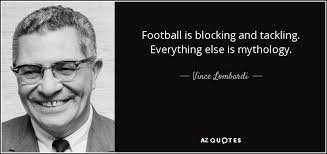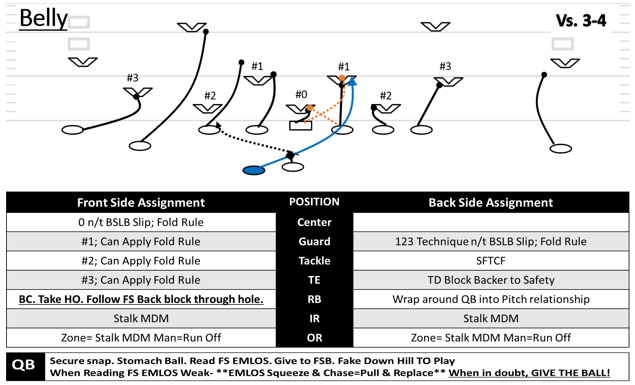In the power spread, we man block or gap block all of our assignments in our run game. We do not zone block in our run game. There are several reasons we choose to man block.
- It is very simple. Every player is responsible for their guy. If a play breaks down, we know who’s responsibility was missed.
- Players know who to block based upon the count. Man blocking tells the player exactly who to block. With zone blocking, who to
 block has a lot of grey area.
block has a lot of grey area. - We get blockers on the backers fast. Most teams put their best players at Linebacker. We want somebody blocking the o
their team’s best players immediately. - Zone blocking can include a lot of grey area of who to block and be very expensive if you want to run it well. Defensive man blocking tells players exactly who to block.
A few acronyms to know while reading this post:
- LOS = Line of Scrimmage
- N/T = Not There
- BSLB = Back Side Line Backer
- SFTCF = Stop Fire Tackle Cross Field
Our man blocking scheme involves a counting system that we use every single play. Our lineman go to the LOS, physically point to defensive men, and verbally count defensive men from the center out both ways. The center counts #0 and #1. The Guard counts #1 and #2. The Tackle counts #2, #3 and sometimes #4, if #4 is a threat to the play. The Tight End counts #3 and # 4 when a Tight end is in the game.
We recognize and count defensive men as follows:
Defensive Man
#0 = First man directly over the Center. There can be no ZERO on a play.
#1 = First man to your side of the Center
#2 = Second man to your side of the Center
#3 = Third man to your side of the Center
#4 = Fourth man to your side of the Center
Coaching Notes:
- If the defense has a nose man (NM) with a stacked middle linebacker (MLB), the NM is ZERO and the MLB is #1. (See Figure C)
- If a Lineman and a linebacker are stacked, the lineman is the FIRST number and the LB is the SECOND number. (See Figure D)

Reminder Coaching Point – Our lineman count defensive man on EVERY SINGLE PLAY. It is the second thing we do when we get to the line after we get our proper splits. We do this to keep the defense from knowing when we are man blocking, gap blocking, pass blocking, etc. We have found that counting also makes the OL look at the defense.
Utilizing these simple counting rules, we block our inside run plays (Belly and Dive) as follows:

A player knows how to block his man based upon the play call. The Belly play above is an inside run play at the 2 or 3 hole. This landmark tells every player inside the 2 hole (Right Guard) to block their man to the inside and every player outside the 2 hole will block their man to the outside. The call side Guard will block his man to the inside or outside depending on what will be easiest and the running back will make a cut accordingly.
Players can also apply our fold blocking rule when needed to have better angles on defensive men. That is designated in with the orange dotted line in the diagram above. We would use or encourage this when the Nose Man will be tough for our center to handle. In a perfect world, we would be able to always block it straight up. As we all know, high school football is anything but a perfect world.
Below is some video of our man blocking schemes with some outside run and inside run plays. We can also run the man scheme with our QB in order to outnumber the defense at the point of attack.
Frequently Asked Questions
Q: Don’t teams know you are going to block them if you point and count them?
A: No. Even though we count defensive man on every play, we don’t always block our numbers. We run gap scheme plays such as Power, Counter, Down, Trap, etc. On those plays as well as pass plays, we count, but don’t particularly block who we count.
Q: What happens if defensive players stem and move after the count?
A: If our players have time to change the count before the snap, they change it. If not, they have to figure out a way to block their number. Below is a video clip of this taking place by our right guard #64.
Our defensive man scheme is a very simple way to get a hat on a hat and combat teams that are too aggressive for the slower developing plays. Also, since a lot of pulling lineman takes place in our offense, teams like to read our guards. We use our man scheme to combat this by putting a lineman in the LB’s lap extremely fast. Our man scheme is always the first scheme we install and give us a chance to see which lineman can really get off the ball.
If you would like to learn more, a free sample of the E-Book, The Power Spread Offense is available below when you sign up for our email list.
I hope you enjoyed reading!
Good stuff.
Coach, Thanks for the comment. It takes the thinking away and allows guys to attack once they determine their guy.